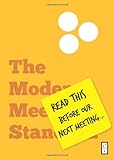 I don’t recall the who, what, when, or where. I just remember the response. Someone a few months ago asked me what I do at the university, and my eight-year-old daughter quickly piped up, “He just goes to meetings all day.” Ouch, the truth hurts.
I don’t recall the who, what, when, or where. I just remember the response. Someone a few months ago asked me what I do at the university, and my eight-year-old daughter quickly piped up, “He just goes to meetings all day.” Ouch, the truth hurts.
Meetings do matter though. They are a must for effective coordination and important interaction with your staff to support their work. But most days include five or six – if not more – meetings, and it’s a constant challenge to find the time needed to do real work. Therefore, I made a New Year’s resolution to have fewer meetings (and fewer bad meetings).
Looking for inspiration, I read Read This Before Our Next Meeting by Al Pittampalli, a manifesto challenging our traditional meeting culture. Mediocre meetings cripple our organization, the author laments, creating a culture of compromise (where game-changing ideas die) and killing our sense of urgency. We’ve all seen it happen…in the face of a pressing, difficult decision, someone calls a meeting instead of taking action.
Pittampalli dreams of a world of fewer meetings, where we would have more time for real work – the work that propels our organization forward. “Work that involves action, struggle, and effort. It’s that output that puts us closer to winning. If the mission could speak, it would constantly tell us, ‘get back to work.’”
His solution is the “modern meeting.” We have to change our mindset about meetings. They are not just another form of communication, but a “special instrument” or “sacred tool.” The modern meeting exists for one reason: to support decisions. That way “bold decisions happen often and quickly” and are converted into forward momentum.
The author outlines seven principals of modern meetings, and there is great content within each. The modern meeting:
- Supports a decision that has already been made.
- Starts on time, moves fast, and ends on schedule.
- Limits the number of attendees.
- Rejects the unprepared.
- Produces committed action plans.
- Refuses to be informational. Reading memos is mandatory.
- Works only alongside a culture of brainstorming.
Here are some of my takeaways to implement for the new year:
- Keep meetings as brief as possible. I have several regular meetings on the calendar for one hour; I’ve changed them to a half-hour. Get in, get out, get to work.
- Be more willing to decline a meeting if necessary. Request a meeting agenda in advance if it is not provided, and upon review, determine if I will really add value to the meeting. Let’s face it: we invite too many people to our meetings, particularly in academia.
- For my own meetings, recommit to ensuring that everyone goes in with a clear purpose and comes out with a clear action plan. What actions are we committing to, who is responsible for each action, and when will those actions be completed?
Regarding a clear purpose, Pittampalli says that modern meetings should center around two things: conflict and coordination.
Conflict: The relevant stakeholders can debate the decision, propose alternatives, suggest modifications, or have concerns addressed. The decision is ultimately resolved.
Coordination: If a decision demands complex collaboration from different people, teams or departments, stakeholders can convene to coordinate an action plan.
Once again, the modern meeting convenes to support the decision, not to make the decision. “After all, decisions are the job of the individual.” This avoids the trap of “over-planning” and “never-ending due diligence.” If you need input pre-decision, you should get it via one-on-one conversations.
Can you lead the emergence of a new meeting culture at your institution? By the time Katherine turns nine, perhaps “He just goes to meetings all day” will be transformed into “He creates change, and when he goes to meetings, they’re awesome!”





Good post! I used to describe my work as “I don’t get to do any real work. I just go to meetings where we talk about work.”
Of course, meetings are sometimes important work. But you describe a chronic problem in organizations and the “modern meeting” ideas are good ones. Unfortunately, I don’t think the problem lies in knowing what makes a good meeting or a bad one; it’s discipline in sticking to this. (We all know how to lose weight or save money, they’re just not easy for many of us to do.)
After trying to direct some attention to our poor meeting culture a while back, I put this website (http://meetronome.heroku.com/) up on the screen for the duration of a large staff meeting. It was highly distracting and it ticked off the boss, but the point was made. I wish I could say there was a substantial change, but within a few weeks things went back to normal.
Thanks for this post – I appreciated it! And I’m grateful that horrible meeting culture isn’t a part of an eight-year-old’s worldview…yet.
Chris
Thanks for the feedback, Chas and Chris! Chas- you raise a very important point about discipline. Reminds me of The Power of Less…all of the book’s useful ideas mean nothing if you don’t have the discipline to carry through and stick with them. (And thanks for the Meetronome link!)